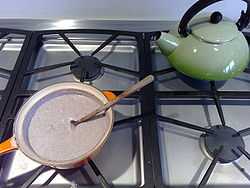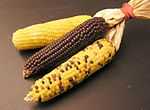Atole
Atole (Mexican Spanish a'tole , from Nahuatl ātōlli /aːˈtoːlːi/) is a traditional hot corn- and masa-based beverage of Mexican origin (where it is known as atol). Chocolate atole is known as champurrado or atole. It is typically accompanied with tamales, and very popular during the Christmas holiday season (Las Posadas).
a'tole , from Nahuatl ātōlli /aːˈtoːlːi/) is a traditional hot corn- and masa-based beverage of Mexican origin (where it is known as atol). Chocolate atole is known as champurrado or atole. It is typically accompanied with tamales, and very popular during the Christmas holiday season (Las Posadas).
The drink typically includes masa (corn hominy flour), water, piloncillo (unrefined cane sugar), cinnamon, vanilla and optional chocolate or fruit. The mixture is blended and heated before serving. Atole is made by toasting masa on a comal (griddle), then adding water that was boiled with cinnamon sticks. The resulting blends vary in texture, ranging from a porridge to a very thin liquid consistency. Atole can also be prepared with rice, flour, or oatmeal in place of masa. In northern Mexico, there is also a variation using pinole (sweetened toasted corn meal). Although atole is one of the traditional drinks of the Mexican holiday Day of the Dead, it is very common during breakfast and dinnertime at any time of year. It is usually sold as street food.
In Northern Mexico and South Texas, atole is a traditional comfort food. It is often eaten as a breakfast or an after dinner snack on cold days. In New Mexico, blue corn atole is finely ground cornmeal toasted for cooking, consumed as a grainy porridge-style drink served warm, usually sweetened with sugar and/or thinned with milk. It is usually served at breakfast like cream of wheat or oatmeal. It is said that elders would drink atole because it gave them energy and if a mother is nursing it gives her more milk.[1] Salvadoran varieties include atol shuco ("dirty" atol, a reference to its darker color), particularly popular in the Cabañas region.[2] The Nicaraguan homologue is pinolillo. In some parts of Honduras, fresh corn is ground and the expressed liquid is used as the base (instead of masa flour).
See also
References
 |
Wikimedia Commons has media related to Atole. |
|
|---|
| | Varieties | | |
|---|
| | Parts | |
|---|
| | Processing | |
|---|
| | Pathology | |
|---|
| Corn-based
products | | Raw materials | |
|---|
| | Beverages | |
|---|
| | Dishes | |
|---|
| | Corn syrup | |
|---|
| | Non-food | |
|---|
| | Misc. | |
|---|
|
|---|
|

![]() a'tole , from Nahuatl ātōlli /aːˈtoːlːi/) is a traditional hot corn- and masa-based beverage of Mexican origin (where it is known as atol). Chocolate atole is known as champurrado or atole. It is typically accompanied with tamales, and very popular during the Christmas holiday season (Las Posadas).
a'tole , from Nahuatl ātōlli /aːˈtoːlːi/) is a traditional hot corn- and masa-based beverage of Mexican origin (where it is known as atol). Chocolate atole is known as champurrado or atole. It is typically accompanied with tamales, and very popular during the Christmas holiday season (Las Posadas).